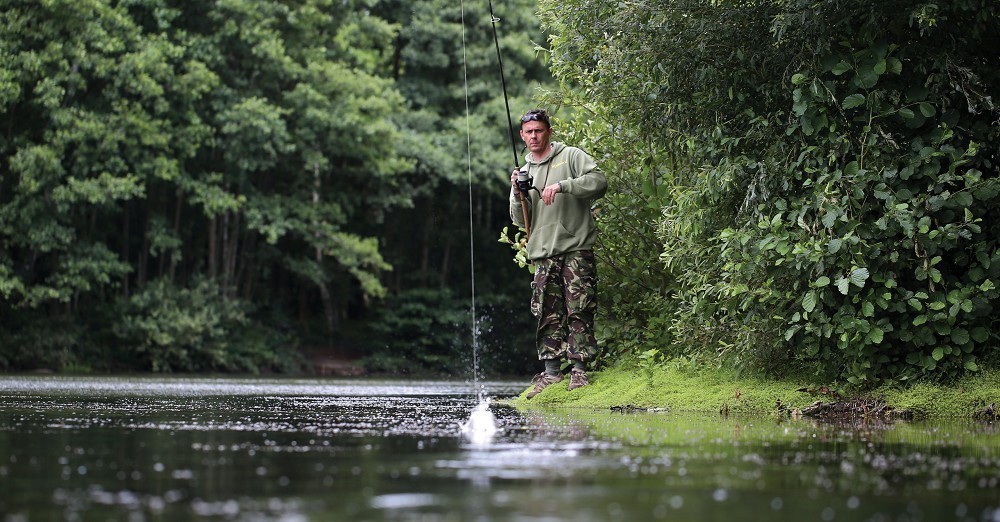
How to find features on gravel pits
Nigel explains about the two types of gravel pits and how he goes about feature finding
t’s obviously very important to know the topography of a lake, and luckily for me I actually saw some of the lakes I now fish get dug, Pit 3 being a good example. This underwater insight, along with learning how to feature find with nylon in the 80’s and 90’s before braid came along has been invaluable. Over the years I’ve learnt to count the float up and down to get the exact depth and now understand that you need to pull the lead back very slowly otherwise you’ll miss features and/or bump the lead over them. Slower the better. I believe through seeing these ‘bare’ lakes and the experience I’ve gained over the last three decades, has helped me build up a better picture what I feel through a rod.
I don’t tend to use a marker float as much these days, mainly because the lake I’m currently fishing I know very well, but on a new lake I probably would send a float to the surface rather than just casting a lead to feel what I’m fishing over.
 Nige uses just one rod for marker work and baiting up, and a simple loop system allows him to change it quickly
Nige uses just one rod for marker work and baiting up, and a simple loop system allows him to change it quicklyThere are two types of gravel pits. One is a ‘maximum extraction’ where they take out every piece of gravel they can, digging down until they hit clay. In the Blackwater Valley this is, on average, between 8 to 10ft. On these types of digs, like Pit 3 and 4 and The Match Lake at Yateley, they generally don’t leave a great deal feature-wise. I think Dinton over in Reading is very similar to that: there’s not a great deal left apart from the sides of the lake and a flat bottom – like a bathtub almost.
The second type is the line-dragged pits, of which there is quite a few in the Colne Valley and we do have a few in the Blackwater Valley, like Old Hollybush Lane Lakes, some of the older lakes at Frimley, such as Pit 1, and The Copse Lake and Nunnery Lake at Yateley, both of which are shallow dug with lots of features left in them. Some have bars running in lines, like Pit 1 at Frimley, and you can also see how they used them as a roadway, digging at either side. I found those types of lakes far more exciting as there’s so much more going on feature-wise. These are the type of features that almost control which direction the fish move around in, whereas on maximum extraction lakes, if they’re not weeded the fish can disappear in any direction.
 Nige uses just one rod for marker work and baiting up, and a simple loop system allows him to change it quickly
Nige uses just one rod for marker work and baiting up, and a simple loop system allows him to change it quicklyThe line-dragged ones do tend to have more to find: they have gravel, they have silt, they have clay, and they have small stones and big stones. In these types of lakes, the silt gets trapped and builds up in the gullies between bars, so it can often be quite deep silt, whereas in maximum extraction lakes it tends to be spread a bit finer all over the bottom of the lake. You will often find the deeper areas are where the undertows will settle and dump a lot of silt. That doesn’t necessarily mean they’re ‘bad areas’ – bloodworm like those areas and you often see loads of bubbling going on, but it’s in these situations you tend to find the carp are bloody hard to catch as they’re up to their gills in the silt feeding.
How Sharpy feature-finds
Nowadays I have just one rod which I use for both leading/marker work and also for Spombing. I’ll then have a cast around the area and feel for a drop. I prefer to use a light lead for this as you can get a false reading with a large lead when casting amongst weed. If you get the instant crackdown drop that you want, or after a few casts you get that drop, where my finger is on the spool is where I will clip it into the line clip. I will then do a few repeat casts to make sure it wasn’t just a fluky one, feathering the line each time with my finger until it hits the clip and then feeling the lead down on a tight line.
From there, if I’m happy with the spot, I will then have a gentle drag back to find out how wide the area is. To do this, I cast out, feel the lead down to the lakebed and then hold the rod at a 90-degree angle to the lake and walk back; doing it this way you get to know (visually) how wide an area is.



